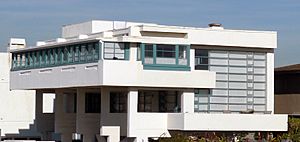Lovell Beach House facts for kids
Quick facts for kids |
|
|
Lovell Beach House
|
|

The Lovell Beach House
|
|
| Location | 1242 West Ocean Front, Newport Beach, CA |
|---|---|
| Built | 1926 |
| Architect | Rudolf Schindler |
| Architectural style | Modern |
| NRHP reference No. | 74000545 |
| Added to NRHP | February 5, 1974 |
The Lovell Beach House is a famous house located on the Balboa Peninsula in Newport Beach, California. It was finished in 1926. This house is considered one of the most important buildings designed by the architect Rudolf Schindler. Many people think it's his second most important work, after the Schindler House he built for his own family. Both of these early houses by Schindler are seen as key examples of early modern architecture in America.
The house is right on the ocean, near a famous surfing spot called The Wedge. It's in a busy neighborhood with many buildings close together. The living areas of the house are built above the ground. This helps protect them from the street on the west side.
Below the main living space, you can see the strong reinforced concrete frames. These frames were shaped like the number 8. Two stairways go through the openings in these frames. They lead up to the kitchen and the main entrance. The garage is on the north side of the ground floor. A garden is on the south side, between the house and the beach.
Inside, the house is built around a large living and dining room that is two stories tall. This room has very tall windows on the east and south sides that face the ocean. These windows are like a "curtain wall" because they cover almost the entire wall. The kitchen and breakfast area are on the north side of the first floor. There is also a terrace on the ocean side, above the garden. The original design included special lamps and built-in furniture. The bedrooms are on the second floor. They are connected by a hallway that looks down over the main living room. Each bedroom used to have its own open "sleeping porch." However, Schindler closed these porches in 1928.
Why This House Was Built
The person who asked for this house to be built was Philip M. Lovell. He believed in a healthy lifestyle, which included proper diet and exercise. Schindler, the architect, also believed in these ideas. He designed the beach house with these health principles in mind.
For example, the living areas are placed on the north side of the house. This helps fresh air move through the house easily. Also, each bedroom has windows on different sides. This allows for "cross ventilation," meaning air can flow through the room from one side to another. This design meant there was no need for air conditioning.
Lovell also asked for another house to be built for him in Los Angeles. This house, called the Lovell "Health House", was finished in 1929. That was three years after the Beach House was completed. This second house was designed by Richard Neutra. Neutra actually lived in a part of Schindler's own house and studio for a few years. Both Schindler and Neutra created houses that became classic examples of new California home design. Their work became important symbols of the Modern movement in America.
Why the Lovell Beach House is Important
The Lovell Beach House is considered a very important building in history. In 1968, a group called the Historic American Buildings Survey (HABS) studied and recorded the house. Today, the house looks very much like it did in the photographs taken during that survey. Even back then, people knew how important the house was.
Experts say the Lovell Beach House is one of the greatest works by the pioneering modern architect, R. M. Schindler. It shows an early use of concrete in a special way. The concrete was left uncovered, and the structure of the building was kept separate from the walls. This style was later seen in a type of architecture called Brutalism.
The house is lifted above the beach. It is held up by five concrete frames shaped like the number 8. These frames were poured right on the building site. The parts of the house that were enclosed were built in a factory and then lifted into place. The way the different parts of the house stick out or go back is similar to the De Stijl art movement. This movement started in the Netherlands in 1917.
The Lovell Beach House was officially listed as a Registered Historic Place in California on February 5, 1974.
See also
 In Spanish: Casa de playa Lovell para niños
In Spanish: Casa de playa Lovell para niños



